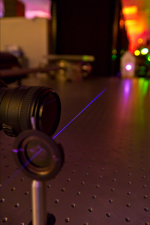Program Summary
A Multidisciplinary University Research Initiative funded by the US Army Research Office.
A decade and a half now old, laser light filamentation in air is still challenging its basic concepts, producing new and unexpected effects, and offering images of possible game-changing applications for the future. However this field is entering a new phase. This is driven by a number of factors including new and more powerful lasers, new understandings of filament manipulation and control, and by observations of new effects produced by filaments. We now stand on the threshold of an era of transformational exploration and development. We bring together a world-class team equipped with the tools and expertise to elevate filamentation from an inexact, phenomenological science to a precision engineering discipline.
We have deliberately reached beyond the field of filamentation itself to explore how molecular optics, attoscience, meta-optics, THz emission and non-linear wave optics, can both aid its understanding and advance its exploitation. Co-lead by Jean-Claude Diels, UNM and Martin Richardson, UCF, it includes Alejandro Aceves, SMU, Ladan Arrisian UNM; Matthieu Baudelet and Zenghu Chang, UCF, Natalia Litchinitser, U. Buffalo, Eric Johnson, Clemson, Tamar Seideman, Northwestern University, Xi-Cheng Zhang, RPI, and colleagues from Canada, See Leang Chin, Laval University, and Paul Corkum, Ottawa University.
In a tightly coordinated program involving experts from Europe and Canada, where leadership in this field currently resides, and colleagues at ARL, NRL and AFOSR, we concurrently address several interwoven issues. These can be listed as the fundamental science of single filaments, the radiation emitted from them, multiple filament formation and their cross interaction, the projection of secondary EM and electrical energy sources with filaments, as well as the interaction science of filament structures with materials.

